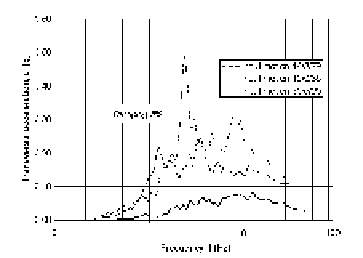Geoscience Reference
In-Depth Information
(a)
(b)
Figure 9.35.
The registered accelerations (a) on the bedrock at the foundation of the dam and
(b) their Fourier transformations
Measurements of settlements and pore water pressure were also made during the
periods of the construction and the earthquakes. These points are shown in Figure
9.34. The recordings on the cofferdam, placed directly on the rock of the foundation,
and their Fourier transform are shown in Figure 9.35. Given the high permeability of
the rocks, they were supposed to function under drained conditions. Thus, a single-
phase model has been used for the rockfill, which takes into account their submerged
mass and works under effective stress. However, in transition zones and in the core, a
biphasic model taking into account the coupling of soil deformation and pore pressure
and transient flow was considered.
A first set of parameters is chosen for the dam material using some experimental
results(onlymonotonictests)availableandtheexistingcorrelations.Thefirstcalculation
of the dam represents the staged construction, impoundment, followed by consolidation
and then the earthquake of March 1979. This set of data is then refined by optimizing
the settlements and pore pressures during construction and the peak accelerations and
displacements induced during the first earthquake. The parameters
β
,
a
1
and
a
2
of the
constitutive model are calibrated to obtain the best estimation of the settlement profile
and pore pressure in the core after construction. In Figure 9.36, we see a comparison of
the patterns of settlement in the core and the evolution of pore pressure in a piezometer
located in the core.
The analysis of the calculated response of the dam during the earthquake of March
14, 1979 showed that, although the settlement profiles and pore pressure after
construction (Figure 9.36) and settlements after the earthquake (Figure 9.37) were
calculated in a satisfactory manner, the rigidity of the dam during the earthquake was


Search WWH ::

Custom Search